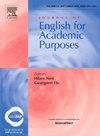How English academic writing textbooks written by Chinese EFL teachers address the issue of plagiarism
Abstract
Studies have examined how EFL students and teachers understand plagiarism and the extent to which they can recognize subtle forms of plagiarism through their knowledge of the international conventions of source use. However, the precise ways in which plagiarism is conceptualized and anti-plagiarism strategies are presented to students in EFL contexts have received surprisingly little research attention. In the study reported in this paper, we investigated how the issue of plagiarism is addressed in English academic writing (EAW) textbooks authored by English language specialists and published in China. We collected a sample of 55 EAW textbooks that included a discussion of plagiarism and extracted the relevant teaching materials into a focal dataset. A qualitative content analysis of this dataset revealed four prominent features: defining plagiarism by international standards, reasoning on the causes of plagiarism among Chinese students, a triadic approach based on textual examples, and a pedagogical spotlight on paraphrasing. We conclude the paper by highlighting the important roles of English teachers and EAW textbooks in anti-plagiarism education in China and elsewhere. Further research is needed to explore how to effectively promote anti-plagiarism education in classrooms.

 求助内容:
求助内容: 应助结果提醒方式:
应助结果提醒方式:


